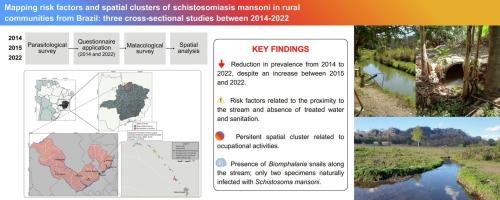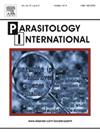巴西农村社区曼氏血吸虫病的风险因素和空间聚集:2014年至2022年的三项横断面研究
IF 1.9
4区 医学
Q3 PARASITOLOGY
引用次数: 0
摘要
本研究旨在确定巴西农村地区人类曼索尼链球菌感染的阳性率,评估社会经济因素和行为因素之间的关系,并确定2014年、2015年和2022年危险区域和危险因素的变化。我们进行了三个横断面研究,包括寄生虫学和线虫学调查,以及风险问卷调查。为了确定与曼氏链球菌感染相关的因素,我们使用了二项广义线性模型。利用核扫描和灵活空间扫描对曼氏链球菌感染高危区进行空间聚集性识别。经过抗寄生虫治疗和教育干预,我们观察到患病率从2014年(45.9%)下降到2015年(10.38%),随后在2022年上升到26.03%。在2014年和2022年,靠近溪流(200米)和缺乏家庭浴室仍然是重要的风险因素。2022年,使用未经处理的水也增加了感染的几率。在Tocantins社区中发现了一个持续存在的高风险集群(相对风险:2.03-4.18),由于供水基础设施项目不完整,居民继续依赖被污染的河流。这些发现揭示了仅基于诊断和治疗的控制策略的局限性。脆弱地区的持续传播凸显了迫切需要采取综合公共卫生行动。要在消除血吸虫病方面取得可持续进展,不仅需要治疗,还需要普遍获得清洁水、改善卫生设施和有针对性的健康教育。像Tocantins这样的高风险聚集性病例需要优先的多部门干预措施,以缩小健康差距并中断再感染周期。本文章由计算机程序翻译,如有差异,请以英文原文为准。

Mapping risk factors and spatial clusters of schistosomiasis mansoni in rural communities from Brazil: three cross-sectional studies between 2014 and 2022
This study aimed to determine the human positivity rate for S. mansoni infection and evaluate the association between socioeconomic factors and behavioral factors, as well as identify risk areas and changes in risk factors over the years 2014, 2015, and 2022 in rural communities in Brazil. We conducted three cross-sectional studies, included parasitological and malacological surveys, as well as risk questionnaires. To identify factors associated with S. mansoni infection, we used binomial generalized linear models. Spatial clusters of high-risk areas for S. mansoni infection were identified using Kernel and Flexible Spatial Scan. After anti-parasitic treatment and educational interventions, we observed a decline in prevalence from 2014 (45.9 %) to 2015 (10.38 %), followed by an increase to 26.03 % in 2022. Proximity to streams (<200 m) and lack of household bathrooms remained significant risk factors in both 2014 and 2022. In 2022, using untreated water also increased the odds of infection. A persistent high-risk cluster was identified in the Tocantins community across all years (relative risk: 2.03–4.18), where residents continue to rely on a contaminated stream due to incomplete water infrastructure projects. These findings reveal the limitations of control strategies based only on diagnosis and treatment. Persistent transmission in vulnerable areas underscores the urgent need for integrated public health actions. Sustainable progress toward schistosomiasis elimination requires not only treatment, but also universal access to clean water, improved sanitation, and targeted health education. High-risk clusters like Tocantins demand prioritized, multisectoral interventions to reduce health disparities and interrupt the cycle of reinfection.
求助全文
通过发布文献求助,成功后即可免费获取论文全文。
去求助
来源期刊

Parasitology International
医学-寄生虫学
CiteScore
4.00
自引率
10.50%
发文量
140
审稿时长
61 days
期刊介绍:
Parasitology International provides a medium for rapid, carefully reviewed publications in the field of human and animal parasitology. Original papers, rapid communications, and original case reports from all geographical areas and covering all parasitological disciplines, including structure, immunology, cell biology, biochemistry, molecular biology, and systematics, may be submitted. Reviews on recent developments are invited regularly, but suggestions in this respect are welcome. Letters to the Editor commenting on any aspect of the Journal are also welcome.
 求助内容:
求助内容: 应助结果提醒方式:
应助结果提醒方式:


